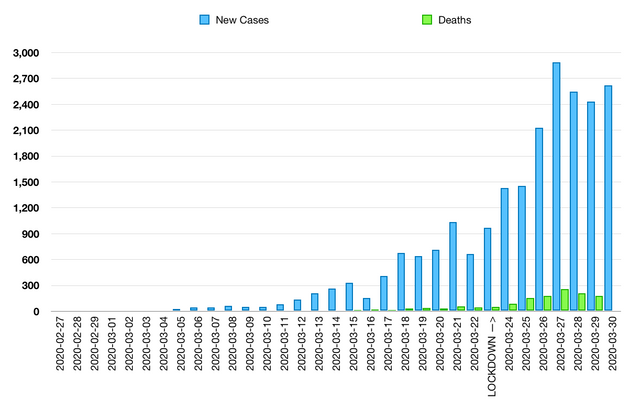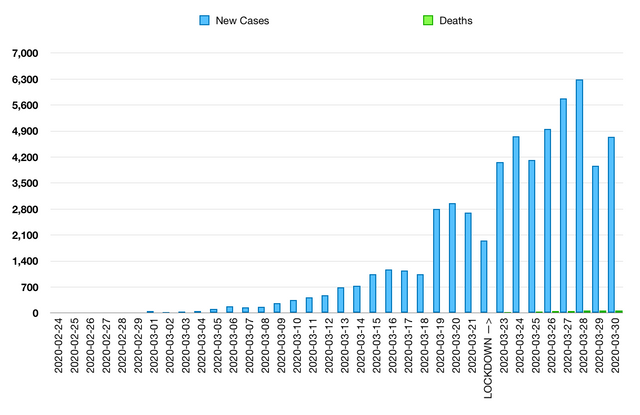Coronavirus Analysis (part 3) - Germany and UK - Why are death rates so much lower in Germany?
Some very basic analysis based on the figures available from wikipedia.
Recap of part 1 - China and part 2 - Italy, Spain & France
In part 1 of this analysis (https://hive.blog/coronavirus/@miniature-tiger/coronavirus-analysis-part-1-how-long-will-lockdown-last) I looked at the coronavirus figures from China and the length and impact of their lockdown.
The broad conclusion was that the lockdown was successful in containing and reducing the epidemic with a timeline of the lockdown as follows:
- Lockdown period to peak of new cases: 2 weeks
- Lockdown period to low number of new cases: 5 weeks
- Lockdown period to potential lifting of quarantine: 7 weeks (although many people still sick in hospital at this point)
- Full lockdown in hardest hit areas: 9 weeks
In part 2 of this analysis (https://hive.blog/coronavirus/@miniature-tiger/coronavirus-analysis-part-2-italy-spain-and-france-are-the-lockdowns-working ) I looked at the coronavirus figures from Italy, Spain & France and compared the impact of their lockdowns to that seen in China with the aim of determining whether the lockdowns were effective.
) I looked at the coronavirus figures from Italy, Spain & France and compared the impact of their lockdowns to that seen in China with the aim of determining whether the lockdowns were effective.
The broad conclusions were that:
The lockdowns appear to be working in Italy and Spain with a few more days of data required to conclude on France.
- The number of deaths will keep going up into the third week of lockdown. That is to be expected and does not mean that the outbreak is getting worse.
- The lockdown in Italy appears to mirror corresponding numbers from China over the last week, suggesting that the lockdown timeline for China (5 weeks to a low number of new cases, 7-9 weeks to potential lifting / lightening of quarantine) could hold.
In this post I look at the coronavirus figures for the UK and Germany to complete the European roundup.
UK
The timing of the coronavirus outbreak in the UK is a couple of weeks behind continental Europe. Lockdown in the UK commenced on 23 March, two weeks after Italy and a week after Spain and France.
As at today the UK is a week into the lockdown period. Here's the chart of new cases and deaths by date for the country as a whole, with the lockdown date highlighted. The data is a little rough, particularly the deaths, because the UK has changed the timing of its reporting over the last week.

Even though it’s quite early in the lockdown period, the numbers of new cases appear to be starting to flatten off. One likely reason for this is that the UK had an extra week or two to prepare with preventative measures (handwashing, isolation if sick etc) prior to the lockdown due to the later onset of the outbreak.
There is a fair amount of discussion in the UK around how long the lockdown will last, with politicians understandably unable to give a clear indication. Newspaper headlines this morning were stating “6 months to get back to normal - we face long shutdown” following a comment from one of the chief scientists. This is typically sensationalist.
It is true that there are likely to be some form of measures in place for a long period; basically until we get a complete worldwide shutdown of cases, a vaccine or an effective treatment. However “measures” does not mean lockdown.
It was more interesting to note the views of one of the Imperial scientists who works on the coronavirus modelling. He stated “end of May / beginning of June” for the lifting of the lockdown which would be 10-11 weeks of lockdown in total. This sounds more realistic.
Germany
Germany has seen far fewer coronavirus deaths (455) than Italy (11k), Spain (7k), France (3k) or the UK (1.4k). However the number of reported cases in Germany (57k) is of a similar magnitude to those countries: Italy 98k, Spain 80K, France 40k, and UK 22k. These figures make it appear that Germany has a much lower death rate from the virus than other countries.
However it is also known that Germany are testing far more people than other countries in Europe. A comparison of these two facts from the UK and Germany throws some more light on the question:
UK: More than 9,000 people who have tested positive for Covid-19 are currently being treated in hospitals across England, NHS England’s chief executive Sir Simon Stevens has said. - i.e. 46% of 19,500 total cases
Germany: Hospitalisation was reported in 4,338 (11%) of the 38,195 COVID-19 cases with data available.
Assuming the virus has a similar effect on people in the UK and Germany, then the number of cases in the UK is understated by 4x in relation to Germany (46% vs 11%). Reducing the German case numbers by 4x to around 14,000 would give the most likely answer to the question of the low death numbers: The outbreak in Germany is smaller than in the more heavily hit European countries.
An alternative explanation is that the outbreak in Germany has mainly infected younger people, whilst in Italy it has affected a lot of older people. There could also be some merit in this argument.
Here's the chart of new cases and deaths by date for the country as a whole, with the lockdown date highlighted.

Germany is 8 days into lockdown. As for the UK, the numbers already appear to be flattening.
Conclusions:
Although we are at an earlier stage of the lockdown period in the UK and Germany compared to Italy, Spain and France, the lockdowns already appear to be working.
The most likely explanation is that the later outbreaks gave additional time to apply preventative measures before the lockdowns started.
The low number of deaths in Germany probably indicates that the outbreak there is smaller than for the other European countries studied.
In the next part of this analysis I will look at the USA.